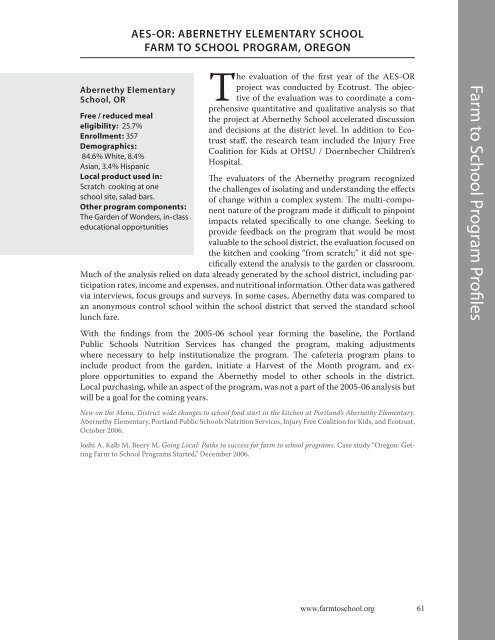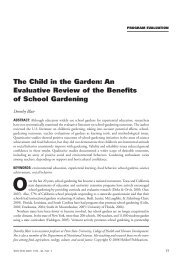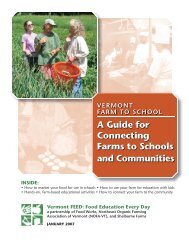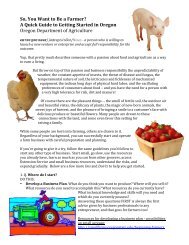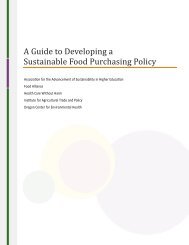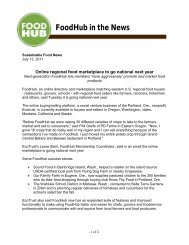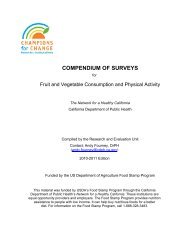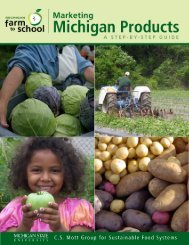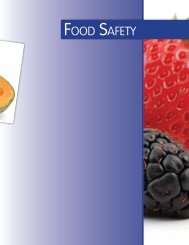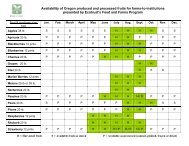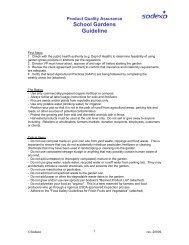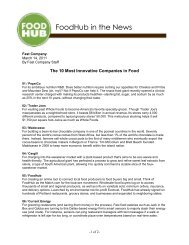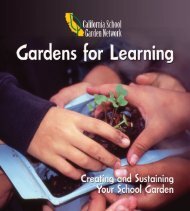Program ProfilesAES-OR: ABERNETHY ELEMENTARY SCHOOLFARM TO SCHOOL PROGRAM, OREGONAbernethy Elementary<strong>School</strong>, ORFree / reduced mealeligibility: 25.7%Enrollment: 357Demographics:84.6% White, 8.4%Asian, 3.4% HispanicLocal product used in:Scratch cooking at oneschool site, salad bars.Other program components:The Garden of Wonders, in-classeducational opportunitiesThe <strong>eval</strong>uation of the first year of the AES-ORproject was conducted by Ecotrust. Th e objectiveof the <strong>eval</strong>uation was <strong>to</strong> coordinate a comprehensivequantitative and qualitative analysis so thatthe project at Abernethy <strong>School</strong> accelerated discussionand decisions at the district level. In addition <strong>to</strong> Ecotruststaff, the research team included the Injury FreeCoalition for Kids at OHSU / Doernbecher Children’sHospital.Th e <strong>eval</strong>ua<strong>to</strong>rs of the Abernethy program recognizedthe challenges of isolating and understanding the effectsof change within a complex system. The multi-componentnature of the program made it difficult <strong>to</strong> pinpointimpacts related specifi c ally <strong>to</strong> one change. Seeking <strong>to</strong>provide feedback on the program that would be mostvaluable <strong>to</strong> the school district, the <strong>eval</strong>uation focused onthe kitchen and cooking “from scratch;” it did not specificallyextend the analysis <strong>to</strong> the garden or classroom.Much of the analysis relied on data already generated by the school district, including participationrates, income and expenses, and nutritional information. Other data was gatheredvia interviews, focus groups and surveys. In some cases, Abernethy data was compared <strong>to</strong>an anonymous control school within the school district that served the standard schoollunch fare.With the findings from the 2005-06 school year forming the baseline, the PortlandPublic <strong>School</strong>s Nutrition Services has changed the program, making adjustmentswhere necessary <strong>to</strong> help institutionalize the program. The cafeteria program plans <strong>to</strong>include product from the garden, initiate a Harvest of the Month program, and exploreopportunities <strong>to</strong> expand the Abernethy model <strong>to</strong> other schools in the district.Local purchasing, while an aspect of the program, was not a part of the 2005-06 analysis butwill be a goal for the coming years.<strong>New</strong> on the Menu, District wide changes <strong>to</strong> school food start in the kitchen at Portland’s Abernethy Elementary.Abernethy Elementary, Portland Public <strong>School</strong>s Nutrition Services, Injury Free Coalition for Kids, and Ecotrust,Oc<strong>to</strong>ber 2006.Conclusions <strong>Farm</strong> <strong>to</strong> <strong>School</strong> and Program RecommendationsProfilesJoshi A, Kalb M, Beery M, Going Local: Paths <strong>to</strong> success for farm <strong>to</strong> school programs. Case study “Oregon: Getting<strong>Farm</strong> <strong>to</strong> <strong>School</strong> Programs Started,” December 2006.www.farm<strong>to</strong>school.org 61
ASA-NC: APPALACHIAN SUSTAINABLE AGRICULTUREPROJECT’S FARM TO SCHOOL PROGRAM, NORTH CAROLINAConclusions <strong>Farm</strong> <strong>to</strong> <strong>School</strong> and RecommendationsProgram ProfilesAppalachian Sustainable Agriculture Project (ASAP)has been leading farm <strong>to</strong> school efforts in westernNorth Carolina – in the Asheville City schools andin the counties of Mitchell, Yancey and Madison. Its “GrowingMinds” program arranges fi e ld trips <strong>to</strong> farms, encouragesparental involvement and education, and facilitates local purchasingby the school system. An extensive <strong>eval</strong>uation of theprogram has not been carried out, though information on theprogram is available from the school districts and ASAP.In 2006, 12,000 children in four school systems - Mitchell,Yancey and Madison counties and Asheville city schools– ate produce from local farms. There was a small, informalnetwork of seven <strong>to</strong> ten farmers providing lettuce, apples, pota<strong>to</strong>es,squash, cucumbers, greens, okra, <strong>to</strong>ma<strong>to</strong>es, decorativepumpkins, turnips, red cabbage, watercress, and zucchini.Most of these farms were less than 10 acres and many were<strong>to</strong>bacco farmers transitioning <strong>to</strong> new crops. A couple of thefarmers were expanding their greenhouses so that they couldgrow vegetables year-round. Th e farmers delivered directly<strong>to</strong> the schools, traveling an average of 30 miles. In Madisonand Mitchell counties, farmers delivered their product <strong>to</strong> onedesignated farmer who then delivered for the group. Localproducts made up 3 – 5% of all produce purchased by theschools.Th e schools in these four counties were equipped with fullkitchens, and food service workers were accus<strong>to</strong>med <strong>to</strong> preparingfresh fruits and vegetables. The only additional facilitiesneeded by a few schools were cold s<strong>to</strong>rage units.One of the biggest benefits of the farm <strong>to</strong> school program inwestern North Carolina was that it provided a connection <strong>to</strong>students’ rural heritage. Many of these children were just onegeneration removed from agriculture, and the exposure <strong>to</strong>farmers and farming helped them <strong>to</strong> understand the his<strong>to</strong>ryof the area as well as how their predecessors lived and worked.<strong>Farm</strong> <strong>to</strong> school found strong supporters among school foodservice staff as well as the school administration, the healthdepartment and staff from a processing facility. ASAP staffhas been enthusiastic about working <strong>to</strong> expand the GrowingMinds program <strong>to</strong> a Head Start group, offering workshopsand field trips <strong>to</strong> different audiences, including farmers andteachers, and focusing on nutrition education by collaboratingwith chefs who are eager <strong>to</strong> offer students the opportunity<strong>to</strong> cook with them.Joshi A, Kalb M, Beery M, Going Local: Paths <strong>to</strong> success for farm <strong>to</strong> schoolprograms. Case study “North Carolina: How the Price of Lettuce Started a<strong>Farm</strong> <strong>to</strong> <strong>School</strong> Program,” December 2006.Mitchell County<strong>School</strong>s, NCFree / reduced mealeligibility: 3.2%Total schools: 8Enrollment: 2200Demographics:94% White, 5% Hispanic,1% African AmericanYancey County<strong>School</strong>s, NCFree / reduced mealeligibility: 51%Total schools: 9Enrollment: 2500Demographics:91% White, 6% Hispanic,2% African AmericanMadison County<strong>School</strong>s, NCFree / reduced mealeligibility: 53.2%Total schools: 6Enrollment: 2600Demographics:97% White, 2% Hispanic,1 % African AmericanAsheville City<strong>School</strong>s, NCFree / reduced mealeligibility: 51.7%Total schools: 10Enrollment: 4400Demographics:49% White, 44% AfricanAmerican, 5% HispanicLocal product used in:Cafeteria mealsOther programcomponents:<strong>Farm</strong> visits by students,school gardens andnutrition education62 Bearing Fruit: <strong>Farm</strong> <strong>to</strong> <strong>School</strong> Evaluation Resources and Recommendations


